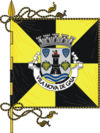Vila Nova de Gaia, Portugal
| Vila Nova de Gaia | |||
|---|---|---|---|
| Municipality | |||

Vila Nova de Gaia seen from Porto.
|
|||
|
|||
 |
|||
| Coordinates: 41°08′N 8°37′W / 41.133°N 8.617°WCoordinates: 41°08′N 8°37′W / 41.133°N 8.617°W | |||
| Country |
|
||
| Region | Norte | ||
| Subregion | Grande Porto | ||
| Metropolitan area | Porto | ||
| District | Porto | ||
| Parishes | 15 | ||
| Government | |||
| • President | Eduardo Vitor Rodrigues (PS) | ||
| Area | |||
| • Total | 168.46 km2 (65.04 sq mi) | ||
| Population (2011) | |||
| • Total | 302,295 | ||
| • Density | 1,800/km2 (4,600/sq mi) | ||
| Time zone | WET/WEST (UTC+0/+1) | ||
| Website | www |
||
Vila Nova de Gaia, or simply Gaia (Portuguese pronunciation: [ˈvilɐ ˈnɔvɐ ðɨ ˈɣajɐ]) is a city and a municipality in Porto District in Norte Region, Portugal. It is located south of the city of Porto on the other side of the Douro River. The city proper had a population of 178,255 in 2001. The municipality has an area of 168.46 km². and a total population of 302,295 inhabitants (2011), making it the most populous municipality in Norte Region. Gaia together with Porto and 12 other municipalities makes up the commonly designated Porto Metropolitan Area.
It is also well known for its cellars (locally known as "caves") where the world-famous port wine is stored and aged. These cellars have become a major tourist attraction.
Vila Nova de Gaia already existed under the Roman Empire as the city of Cale. It developed most likely from a preexistent Celtic Castro, or Neolithic settlement. The origin of the name Cale (or Gale, since in Classical Latin there was not always a clear distinction between the letters "g" and "c") is likely Celtic, from the root "Gall-" with which Celts referred to themselves, similarly to Galicia, Gaul or Galway. The river itself has a Celtic name, Douro (Latinised Durus) after Celtic "dwr", deep water, water or river. In Roman times the bulk of the population probably lived south of the river Douro, and on the north side, there was a smaller settlement around the deep water port which now is the Ribeira neighbourhood of Porto. The name of Porto, in high medieval times Portus Cale, thus stood for the harbour ("portus" in Latin) of the city of Cale. With the important trade of the river Douro, which is easily navigable up to the Régua deep inland, the Porto part of the city came to overgrow Cale, and became the most important part of town, where the Bishopric and the merchants were established.
...
Wikipedia


